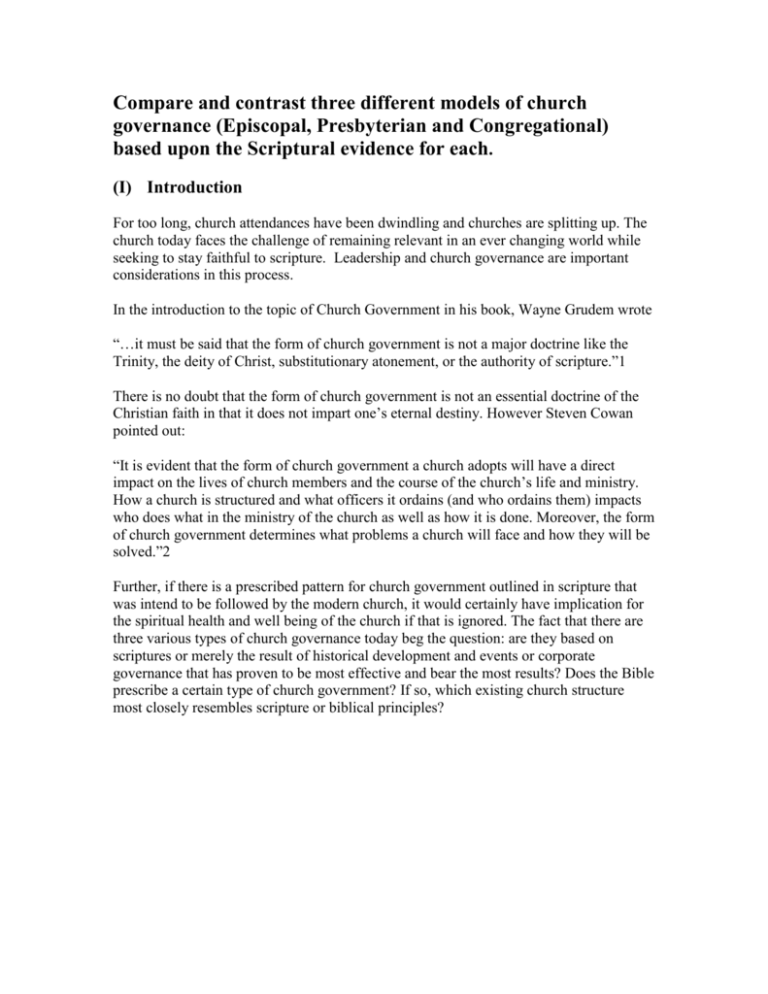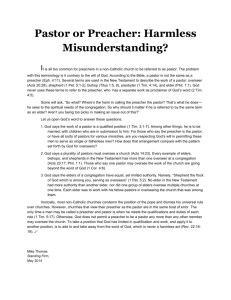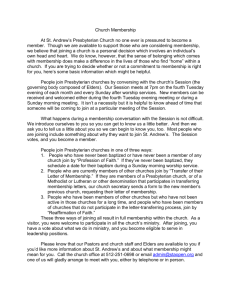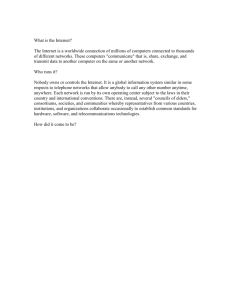Compare and contrast three different models of church
advertisement

Compare and contrast three different models of church governance (Episcopal, Presbyterian and Congregational) based upon the Scriptural evidence for each. (I) Introduction For too long, church attendances have been dwindling and churches are splitting up. The church today faces the challenge of remaining relevant in an ever changing world while seeking to stay faithful to scripture. Leadership and church governance are important considerations in this process. In the introduction to the topic of Church Government in his book, Wayne Grudem wrote “…it must be said that the form of church government is not a major doctrine like the Trinity, the deity of Christ, substitutionary atonement, or the authority of scripture.”1 There is no doubt that the form of church government is not an essential doctrine of the Christian faith in that it does not impart one’s eternal destiny. However Steven Cowan pointed out: “It is evident that the form of church government a church adopts will have a direct impact on the lives of church members and the course of the church’s life and ministry. How a church is structured and what officers it ordains (and who ordains them) impacts who does what in the ministry of the church as well as how it is done. Moreover, the form of church government determines what problems a church will face and how they will be solved.”2 Further, if there is a prescribed pattern for church government outlined in scripture that was intend to be followed by the modern church, it would certainly have implication for the spiritual health and well being of the church if that is ignored. The fact that there are three various types of church governance today beg the question: are they based on scriptures or merely the result of historical development and events or corporate governance that has proven to be most effective and bear the most results? Does the Bible prescribe a certain type of church government? If so, which existing church structure most closely resembles scripture or biblical principles? (II) Models of Church Government Current forms of church government can be categorized into three main models: Episcopalian, Presbyterian and Congregational. For the rest of this project, I will compare and contrast the three models based on the scriptural evidence for each of them. (A) Episcopalian Definition: Episcopal polity is a form of church governance that is hierarchical in structure with the chief authority over a local Christian church resting in a bishop.3 While there are variations on important details, Episcopal bodies share the following features. Distinguishing features: Has office of bishop distinct and superior to the officers of local churches (priest or rector) Hierarchical in structure The bishop ordains and governs the priests and rectors of several local parish churches (diocese). Many has an archbishop which has authority over many (or all) other bishops Episcopalian Structure Archbishop Bishop Bishop Rector Rector Rector Rector Congregation Congregation Congregation Congregation The Episcopal form of church government is found in many churches today. Perhaps the most well-known and straightforward form is found in the Roman Catholic Church. Among Protestants, the Anglican Church, the United Methodist Church and some Lutheran groups all have variation of the Episcopal form. Scriptural Evidence There appears to be little scripture evidence for this form of government. However Charles Gore claimed divine right for this form of government, contending that local bishops, “like the circle of twelve round their Master,” are the successors of the apostles and hence of Christ himself and always had authority over presbyters.4 While acknowledging that this form of church government is not mentioned in the New Testament, advocates maintained that it is not forbidden and that it was a natural outgrowth of the development of the church.5 For example, E.A Litton writes, “No order of Diocesan Bishops appears in the New Testament,” but goes on to say : The evidence is in favor of the supposition that Episcopacy sprang from the Church itself, and by a natural process…..The Presbytery, when it assembled for consultation, would naturally elect a president to maintain order; first temporary, but in time with permanent authority…Thus it is probably that at an early period an informal episcopate had sprung up in each Church. As the Apostles were one by one removed…the office would assume increased importance and become invested with greater power.6 Litton maintains that the episcopacy has benefited the church, especially in being able to claim its authority comes from direct descent from the apostles and should be preserved.7 The fact that it went virtually uncontested until the time of the Reformation is claimed by its advocate as a testimony to its claims of apostolicity. As Robert Reymond noted, episcopacy receives no support whatever from the New Testament and its perceived benefit highly debatable, depending on how one view its development through history.8 J B Lightfoot contended that “the episcopate was created out of the presbytery” due to expediency rather than divine right.9 Shelley noted that the rise of episcopacy gave rise to the papacy and coincides with doctrinal heresies and political and social abuse of power. Many in the third century felt that the coming of episcopacy meant the departure of the Spirit. It may be more than a coincident that at the beginning of the third century, “the extraordinary moral fiber in the church weakened… By the year 220 it was evident that the Christian churches, together with their bishops and clergy, were no longer what they had been.”10 (B) Presbyterian Definition: Presbyterian (or presbyteral) polity is a method of church governance typified by the rule of assemblies of presbyters, or elders.11 It can be described as a “representative” form of church government. Distinguishing Features : The local church is governed by a group of elders (often called a session) The elders are elected by the congregation. The pastor of the church is seen as one of the elders in the session with a specialized role but equal in authority to the other elders. Members of the sessions from several local churches in a geographical area are also members of the presbytery which has ruling authority over these churches. Some members of the presbytery are in turn members of the “general assembly” which usually have authority over all the churches in a region or nation. Presbyterian Structure General Assembly Presbytery Presbytery EEEEEE Session EEEEEE Session EEEEEE Session EEEEEE Session Congregation Congregation Congregation Congregation There is great support for this system among evangelical Christians today. Arguments in favor of this system of church government include : (1) those who has wisdom and gifts for eldership should be called upon to use their wisdom to govern more than just one local church; (2) a national government of the church reflects the unity of the body of Christ; (3) this structure provides safeguards to prevent an individual congregation from falling into doctrinal error more effectively that loosely associated churches. 12 Scriptural Evidence Advocate for this form appeals to both its historical precedence beginning from the Old Testament into the New Testament as well as its effectiveness for church governance. Reymond, a strong advocate of this form of church government noted that, “Moses, the priests and Levites, the judges and even the kings of Israel, were all assisted in their governance of the nation, with God’s permission, by the “elders of Israel [or more striking, ‘elders of the congregation’]” This practice continued into the New Testament as is evident from Luke 22:66 where the “council of the elders” were present at Jesus’ trial. It is this practice of governance that in turn led to Paul’s practice of appointing a plurality of elders in every church he planted, to govern and oversee it. 13 The argument for a plurality of elders to oversee and govern the church is strong. While most are unanimous regarding the governance of local churches by a group of elders elected by the congregation, there is disagreement to the biblical basis for elders having regularly established authority over more than their own local church. In defending this, Reymond maintained that the New Testament were connected or bound together by a common government. He argues that this principle of mutual accountability, dependency, and submission among the churches can be found at several places in Scripture. He points to Acts 8:14 where the Jerusalem church sent Peter and John to investigate Philip’s work in Samaria, and in Acts 13:1-3 and 14:27, where missionaries were sent out by the Antioch church and returned to Antioch to report on the state of the Gentile churches they have founded. However his primary basis for the claim of the connectional nature of the churches in the early church is Acts 15. From this account where an appeal was made by the Antioch church to the apostles and elders in Jerusalem, he observed that the issue was deliberated upon and a decision rendered that appeared to be binding, not just to the church in Antioch but to the churches and Syria and Cilicia as well (Act 15:23). This led him led him to conclude that these congregations were not independent and autonomous. Rather they were mutually submissive, dependent and accountable to each other.14 Grudem however question that account as a sound basis for building a system whereby elders have authority over more than their local churches. Specifically Reymond pointed out that not only the elders but the church was involved in the decision (Acts 15:22). He also pointed out that elders from the other churches were not involved in the deliberation.15 (C) Congregation Definition : Congregationalist polity, often known as congregationalism, is a system of church governance in which every local church congregation is independent, ecclesiastically sovereign, or "autonomous".16 Among contemporary churches, perhaps the most popular form of government is the congregational church government. Unlike the other two, the final governing authority resides within the congregation itself. However the issue of whom in the local congregation exercises final authority differs among congregations. Wayne highlights 5 variation under this form : the “single elder (or single pastor) form, the “plural local elders” form, the “corporate board” form, the “pure democracy” form, and the “no government but the Holy Spirit” form.17 By far, the “single elder” and “plural local elders” form appear to be the two most common among independent churches. For purpose of this project, I will focus on the “single elder” form but will briefly touch on “plural local elders” form. Distinguishing Features (single elder): Final governing authority resides within the congregation itself. The congregation elects one elder or pastor as its spiritual leader who makes the final decision for the church. The single elder is usually assisted by (or in some cases supervised by) a group of deacons who are also elected by the congregation. Single Elder Form Pastor DDDDDD Deacon Board CONGREGATION Scripture Evidence A.H Strong set out the following four arguments for the “single elder (pastor)/ several deacons” form of government.18 1. The New Testament does not require a church to have a plurality of elders in every case and was only advocated for larger churches. 2. In Revelation 2-3—The “angel” in each of the seven churches refers to a single elder or pastor, which indicates that each church had not many but only one bishop/elder or pastor. 3. From Acts 12:17; 21:18, Gal 2:12, he argues that James was the sole pastor of the Jerusalem church. 4. From 1 Tim 3:2 (cf. Titus 1:7) he argues that "bishop" is singular, while "deacons" (1 Tim 3:8) is plural. This would seem to argue that there was but one bishop/elder per church, while there would have been several deacons. The biblical bases for all four arguments are unconvincing. Firstly, the consistent pattern in the New Testament is that every church had several elders. As Grudem highlighted, there were elders appointed “in every church” (Act 14:23) which included churches founded on Paul first missionary journey. And “every town” (Titus 1:5) on the island of Crete was to have elders, regardless of size. Strong’s interpretation of the “angel” in Rev 2-3 as a single elder is suspect, for it is clear that the church at Ephesus in Rev 2:1-7, according to Acts 20:17 had several elders. As such whatever the “angel” of the church at Ephesus was, it cannot be interpreted that there was only one elder in that church. Grudem further pointed out that the church in Ephesus at that time was exceptionally large. If “the angel of the church in Ephesus” implies a single elder at the church, it contradicts Strong’s own argument that the large churches had plural elders. Strong’s argument that James was the sole pastor of the Jerusalem church is again easily refuted by the presence of the elders in the church in Jerusalem in Act 15:2. Granted that James may well have acted as moderator or presiding officer in the church in Jerusalem for purpose of meetings, it does not logically lead to the conclusion that he was the “pastor” of the church in Jerusalem in a :single elder” sense. His final argument of single bishop and many deacons in scriptures is flimsy at best. It is well documented that the two terms, “bishop” and “elder” are synonymous. As such, it is unlikely that only one bishop/pastor is in view because otherwise it is difficult to explain 1 Tim 5:17 ("let the elders who rule well be considered worthy of double honor") and Titus 1:5 "appoint elders in every town"). 19 History has shown that where authority is concentrated on a single person in top leadership level, it has resulted in a disproportionate high number of moral failures. The “single elder” form suffers from a lack of mutual accountability. Many in this position can also suffer from excessive demands laid on them by the church. I believe it is this deficiency that has given rise to the plural local elder form of government. This form effectively preserves the pattern of plural elders while restricting authority to the local congregation. Whatever the variation, Berkhof has the following criticism of the Congregational structure as a whole: The theory that each church is independent of every other church fails to express the unity of the Church of Christ, has a disintegrating effect, and opens the door for all kinds of arbitrariness in church government. There is no appeal from any of the decisions of the local church. 20 (III) Conclusion The church is a living organization. Yet there are organizational aspects that need to be addressed as it grows in size. These two differing but related aspects of Church Governance need to be held in delicate tension. Many different forms of church governance exist today. Having examined the scriptural evidence for the three main existing models of church government, the Episcopalian, Presbyterian and Congregational, I have come to the following conclusions. There appears to be little scriptural support for episcopacy. I think this is significant. Its claim to divine right is unsupported and unverifiable and its perceived benefit to the church debatable. Controlling hierarchies that squash initiative and an active searching for truth tends to lead to ineffectiveness and stagnation. It is also worth noting that the rise of episcopacy has contributed to the rise in political and social abuse of power. Recent revelations of sexual abuses in the Catholic Church worldwide appear to support this. The scriptural evidence for the Congregational variation of the “Single Elder/Pastor” form is likewise weak, and for good reasons. The lack of mutual accountability has led to a high rate of moral failure among pastors of such churches. Because of the nature of man, mutual accountability is necessary. Single pastor churches also risked putting too much demand on the pastor. There is a consistent pattern in the New Testament that every church had several elders who oversee and govern the church with equal authority. The shift by independent churches to a “plural local elders” form appears to address these shortcomings. However the issue of local independence without accountability to a wider body remains a shortcoming for the congregational model. I know I’m just scratching the surface on this topic of church government. However I’m inclined at this junction to lean towards the Presbyterian form of church government which appears to provide a good balance between strong centralized authority and decentralized control. I’m persuaded that it is the most biblical framework for a “trustworthy, just, and peaceful way for the church to determine its direction, its principles, its practices and its priorities, and to resolve its differences. 21. Having said that, I’m mindful that there is no perfect model. Each existing form of church government has its strength and weaknesses. In many ways, churches tend to rise and fall based on the quality of their leaders. Strong godly, servant leadership is critical whatever form of government. However much of what we do in the church today, while not wrong by themselves may not be biblical but has developed over time. There is a need to go back to scripture and try to appropriate the biblical principles of church leadership so that the church can remain relevant and effective. Notes: 1. Wayne Grudem, Systematic Theology (Grand Rapids, Mich. :Zondervan,1994), 904 2. Steven B. Cowan, Who Runs the Church? : 4 Views on Church Government. (Counterpoints : Church Life), Introduction. 3. / http://en.wikipedia.org/wiki Episcopal_polity 4. Charles Gore, The Church and the Ministry, rev. ed. (London: Longmans, Green, 1919), 302-03, 348-49. 5. Robert L Reymond, A New Systematic Theology of the Christian Faith, 2nd ed. (Nashville: Thomas Nelson, 1998), 905 6. Edward Arthur Litton, Introduction to Dogmatic Theology, ed. Philip E. Hughes (1882,1892; reprint, London : James Clarke, 1960), 401 7. Edward Arthur Litton, Introduction to Dogmatic Theology, 390. 8. Robert L Reymond, A New Systematic Theology of the Christian Faith, 905 9. J B Lighfoot, The Epistle to the Philippians, rev. ed (Grand Rapids, Mich.:Zondervan, 1974), 95 10. Bruce Shelley, Church History in Plain Language, upd. 3rd ed. (Nashville : Thomas Nelson, 2008), 70 11. http://en.wikipedia.org/wiki/presbyterian_polity 12. Wayne Grudem, Systematic Theology, 926 13. Robert L Reymond, A New Systematic Theology of the Christian Faith, 897 14. Robert L Reymond, A New Systematic Theology of the Christian Faith, 900 -01 15. Wayne Grudem, Systematic Theology, 927 16. http://en.wikipedia.org/wiki/congregational_polity 17. Wayne Grudem, Systematic Theology, 928-36 18. Augustus H. Strong. Systematic Theology (Philadelphia:Judson, 1907), 914-17 : 19. Wayne Grudem, Systematic Theology, 928-36 20. Louis Berkhof, Systematic Theology (Grand Rapids, Mich.: Eerdmans, 1932), 580-81 21. Robert L Reymond, A New Systematic Theology of the Christian Faith, 908





